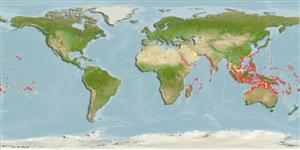Common names from other countries
>
Anguilliformes (Eels and morays) >
Muraenidae (Moray eels) > Muraeninae
Etymology: Gymnothorax: Greek, gymnos = naked + Greek, thorax, -akos = breast (Ref. 45335).
More on author: Bleeker.
Environment: milieu / climate zone / depth range / distribution range
Sinh thái học
Biển Cùng sống ở rạn san hô; Mức độ sâu 0 - 50 m (Ref. 30573). Tropical; 30°N - 25°S
Indo-Pacific: Red Sea and East Africa (Ref. 33390) to the Marquesas and Oeno Atoll (Pitcairn Group), north to the Ryukyu and Hawaiian islands, south to New Caledonia and the Austral Islands.
Bộ gần gũi / Khối lượng (Trọng lượng) / Age
Maturity: Lm ? range ? - ? cm
Max length : 300 cm TL con đực/không giới tính; (Ref. 9710); Khối lượng cực đại được công bố: 30.0 kg (Ref. 30404)
Các tia vây lưng cứng (tổng cộng) : 0; Tia cứng vây hậu môn: 0; Động vật có xương sống: 137 - 143. Juveniles are tan with numerous large black spots. Adults have black specks that grade into leopard-like spots behind the head and a black area surrounding the gill opening.
Found in lagoon and seaward reefs. Commonly seen species along deep drop-offs and slopes in Indonesian waters (Ref. 48635). Benthic (Ref. 58302). Juveniles more secretive and occur on intertidal reef flats (Ref. 37816). It feeds primarily on fishes and occasionally on crustaceans. This is the largest Indo-Pacific moray eel (Ref. 30404), perhaps reaching 3 m in length. Because of its position at the top of the reef's food chain it is often ciguatoxic. Attacks humans when provoked (Ref. 3132). Minimum depth reported taken from Ref. 10713. Solitary in reef holes (Ref 90102).
Observations on prespawning behavior include a pair entwined around one another lying on the bottom of the reef area (Ref. 93344).
Chen, H.-M., K.-T. Shao and C.T. Chen, 1994. A review of the muraenid eels (Family Muraenidae) from Taiwan with descriptions of twelve new records. Zool. Stud. 33(1):44-64. (Ref. 6934)
IUCN Red List Status (Ref. 130435)
CITES (Ref. 128078)
Not Evaluated
Threat to humans
Reports of ciguatera poisoning (Ref. 4690)
Human uses
Các nghề cá: Các nghề cá là sinh kế; Bể nuôi cá: Bể cá công cộng
Các công cụ
Special reports
Download XML
Các nguồn internet
Estimates based on models
Preferred temperature (Ref.
115969): 25.5 - 29, mean 28.1 (based on 902 cells).
Phylogenetic diversity index (Ref.
82804): PD
50 = 0.5000 [Uniqueness, from 0.5 = low to 2.0 = high].
Bayesian length-weight: a=0.00052 (0.00033 - 0.00084), b=3.27 (3.14 - 3.40), in cm Total Length, based on LWR estimates for this species & Genus-body shape (Ref.
93245).
Mức dinh dưỡng (Ref.
69278): 3.9 ±0.64 se; based on food items.
Thích nghi nhanh (Ref.
120179): Chiêù cao, thời gian nhân đôi của chủng quần tối thiểu là dưới 15 tháng (Fec = 200,000-300,000).
Fishing Vulnerability (Ref.
59153): Very high vulnerability (90 of 100).
